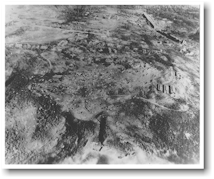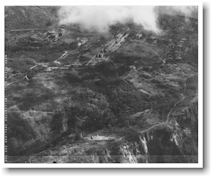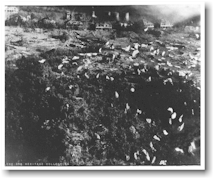|

As the aircraft passes over Battery Crockett, it presents a
comprehensive view of Landing Zone B. Middleside Barracks is at top
right.

This
pre-bombing photograph has caught a Japanese vehicle on the road between
Battery Cheney and the crest of Wheeler Point. In the left mid-ground is
Battery Hearn, and behind it, Way Hill. In the background, Topside is
laid out like a table setting.

A long lens brings Landing Zone B into perspective, with Crockett
Ravine (foreground) and the lighthouse / water towers in the background. |

|
Some of the officers who came down with the
first lift felt that conditions were too hazardous to risk
dropping the rest of the 503d and wanted to halt the second
lift. 12 But
no command action was taken to stop the second lift, which began
dropping at 1240 hours, twenty-five minutes behind schedule.
This lift was composed of the 2d Battalion, 503d Parachute
Infantry; Battery B, 462d Parachute Field Artillery Battalion;
Service Company, 503d Infantry; and the remainder of
Headquarters, 503d RCT. The planes came in at the proper
altitude, and, although the wind was still strong, most of the
'troopers landed on the drop zones. The second lift encountered
some fire from Japanese automatic weapons, but suffered fewer
casualties than had the first drop.13
Of the 2,050 men dropping on 16 February,
jump casualties numbered approximately 280. The resultant rate
of 14 percent was 6 percent lower than that the planners had
been willing to accept. Japanese fire and crashes into buildings
had killed approximately 20 'troopers, roughly 210 were injured
on landing, and Japanese fire had wounded another 50 men during
the descent.
While Colonel Jones talked with his staff
about the advisability of continuing jump operations on 17
February, the troops on the ground began expanding a hurriedly
formed perimeter around the drop zones. The 2d Battalion took
over at the two drop fields and the 3d Battalion's Companies G
and H--there were only three companies per battalion in the 503d
Infantry--set out to secure the rest of Topside. Company H,
assembling at the parade ground, rapidly cleared the main
barracks building of a few Japanese stragglers and then moved
300 yards northward to secure the gutted hospital, whence one
platoon dashed 600 yards northeast to seize a knoll dominating
the entire northeast section of Topside. Company G, meanwhile,
advanced eastward down the slopes toward Middleside to set up
night positions near the head of Ramsay Ravine, only 250 yards
from the closest elements of the 3d Battalion, 34th Infantry.
The rest of the 503d's troops, patrolling all over Topside,
discovered that Japanese strength seemed to be located west and
south of the drop zones. By dusk combat casualties numbered
about 55 men wounded, a much lower figure than anticipated.
In the meantime, the question of additional
drops had been settled. Colonel Jones felt that since the
operation had been successful beyond hope, opposition had been
lighter than expected, and the Japanese were obviously surprised
and disorganized, there was no need to risk further jump
casualties. Accordingly, he requested XI Corps to cancel the
drop of the rest of the regiment in favor of sending it forward
by landing craft to Bottomside. The request was approved, and
only supplies were dropped on the 17th. 14
One unexpected blessing resulted from the
scattered drop of paratroopers in the 0830 lift. Captain Itagaki,
having been informed that landing craft were assembling off
Mariveles, had hurried with a small guard to an observation post
near Breakwater Point, obviously more concerned with the
imminent amphibious assault than with the possibility that
paratroopers might drop out of the C-47's already in sight of
Corregidor. Suddenly, his attention was rudely diverted as
twenty-five to thirty paratroopers who had been blown over the
cliffs near the point began pelting down around the observation
post. Fired on by the Japanese, the small American group quickly
assembled and attacked. In the ensuing skirmish eight Japanese,
including Captain Itagaki, were killed. Effective control among
the Japanese units, already rendered practically impossible by
the destruction of the communications center during the
preassault air and naval bombardment, now ceased altogether.
Leaderless, the remaining Japanese were no longer capable of
coordinated offensive or defensive efforts. Each group would
fight on its own from isolated and widely separated strongpoints. |
|
   |
|
|

|
|
|

